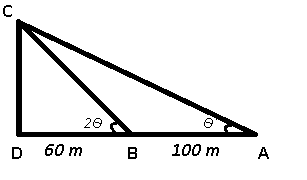A tower standing on a horizontal plane subtends a certain angle at a point 160 m apart from the foot of the tower. On advancing 100 m towards it, the tower is found to subtend an angle twice as before. The height of the tower is
Solution

Given : CD is the tower, AD = 160 m and AB = 100 m
=> BD = 160 - 100 = 60 m
To find : CD = $$h$$ = ?
Solution : $$\angle$$ DBC = $$2\theta$$ and $$\angle$$ DAC = $$\theta$$
In $$\triangle$$ ACD,
=> $$tan(\theta)=\frac{CD}{DA}$$
=> $$tan(\theta)=\frac{h}{160}$$ -----------(i)
Similarly, in $$\triangle$$ BCD,
=> $$tan(2\theta)=\frac{CD}{DB}$$
=> $$tan(2\theta)=\frac{h}{60}$$
=> $$\frac{2tan\theta}{1-tan^2\theta}=\frac{h}{60}$$
Substituting value from equation (i), we get :
=> $$2\times\frac{h}{160}=[1-(\frac{h}{160})^2]\times(\frac{h}{60})$$
=> $$\frac{60}{80}=1-(\frac{h}{160})^2$$
=> $$(\frac{h}{160})^2=1-\frac{3}{4}=\frac{1}{4}$$
=> $$\frac{h}{160}=\sqrt{\frac{1}{4}}=\frac{1}{2}$$
=> $$h=\frac{160}{2}=80$$
$$\therefore$$ Height of tower is 80 m
=> Ans - (A)
Create a FREE account and get:
- Free SSC Study Material - 18000 Questions
- 230+ SSC previous papers with solutions PDF
- 100+ SSC Online Tests for Free

